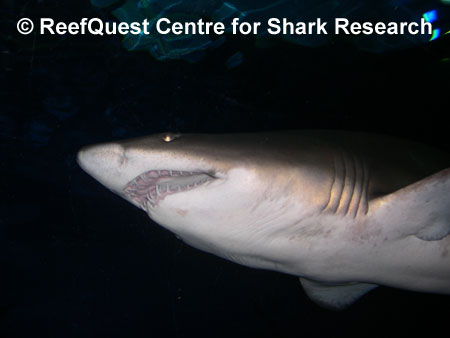Rocky Reefs: Rich Feeding in Cool Waters
Sandtiger Shark
Due to its ferocious appearance, the Sandtiger Shark (Carcharias taurus) has long been brutalized under the prejudice that it must be a dangerous killer. In truth — unless hooked, stabbed, grabbed, speared, or otherwise molested — this species is quite harmless toward humans. Unfortunately, the Sandtiger’s inoffensive nature did not become widely known until many of its populations had been decimated. Only now are we starting to appreciate the fascinating creature behind that fearsome, snaggle-toothed grin.
Just the Facts:
Size:
Reproduction:
Diet:
Habitat: Sandy Plains, Rocky Reefs, Coral Reefs Depth: surf zone - 300 ft (90 m) Distribution: Western North Atlantic, Caribbean, Argentinean, Eastern North Atlantic/Mediterranean, West African, Southern African, Madagascaran, Arabian, Indian?, South East Asian, Western Australian, Southeast Australian/New Zealand, Northern Australian, Japanese |
Also known as the Ragged-Tooth Shark, the Sandtiger has frighteningly prominent anterior teeth — dagger-like in the upper jaw, claw-like and seeming to spill from the lower. Given its impressive toothiness, it is no surprise that the Sandtiger is a fearsome predator. Its slender, smooth-edged teeth are well suited to grasping prey small enough to be swallowed whole. Intriguingly, the Sandtiger’s prey is usually not snagged by the large anterior teeth. Instead, prey is typically captured by the smaller teeth near the jaw corners with a sudden sideways swipe of the Sandtiger’s flattened head.

Underside of the head of a Sandtiger, showing the ampullae of Lorenzini,
nares and slender teeth.
On several occasions, Sandtigers have been reported to feed co-operatively. In one case, a school of a hundred or more Sandtigers was observed working together to capture a school of Bluefish (Pomatomus saltatrix) at Cape Lookout, North Carolina. The sharks systematically surrounded the school of Bluefish, drove them en masse into shallow water, then — at the same instant — dashed in to feast on their concentrated prey. Such co-operative feeding would certainly increase each Sandtiger’s feeding efficiency.
Sandtigers are also highly social in other respects. Large aggregations of up to 80 individuals are often seen near certain shipwrecks off North Carolina and in the caves at Aliwal Shoals, off Natal, South Africa. These gatherings may be associated with Sandtiger mating, or they may simply be refuging — aggregating about a convenient landmark specifically to interact socially. At Seal Rocks, off New South Wales, Australia, Sandtigers are often encountered in large groups of 20 to 30 individuals. For unknown reasons, these sharks gather in sandy chutes between parallel rocky reefs called “shark gutters”, where they seem to float almost motionless.

How Sandtiger Sharks are able to ‘float’ has long been something of a mystery. Like other sharks, Sandtigers’ bodies are more dense than seawater, and thus would be expected to sink when not actively swimming. However, it was discovered that Sandtigers have developed a neat trick for achieving neutral buoyancy: they gulp air at the surface and hold it in the forward part of the stomach, turning this food-storage organ into a kind of built-in swim bladder or buoyancy compensator. Sandtigers can apparently fine-tune their buoyancy by releasing air from their mouth, gill slits, or — occasionally — cloacae. As a result, groups of Sandtigers can float motionless like a gentle herd of submerged cattle.
However, there is nothing ‘gentle’ about Sandtiger Sharks as they develop within their mothers’ wombs. About halfway through their gestation period, Sandtiger embryos develop precocious dentition and swimming ability. This was first discovered accidentally: a pioneer shark biologist using his bare hands to probe the uteri of a pregnant Sandtiger was astonished by the distinct impression he had been bitten; sure enough, when he examined his finger, he discovered tiny puncture marks oozing blood. More recent research has demonstrated that the largest or strongest of the late-term pups in each uterus augments its diet of unfertilized eggs by attacking and consuming lesser siblings. Termed ‘adelphophagy’ (literally, “eating one’s brother”), this is the only known case of intra-uterine cannibalism in the Animal Kingdom. Eventually, only two pups are born per litter, one from each uterus. Each is unusually large and has a distinctly swollen belly — a grim reminder of the fierce competition it had to endure during embryonic development.

Unlike many shark species, Sandtigers adapt well to captivity. As a result, we have learned quite a bit about the basic biology of this species. We learned, for example, that — like many cold-blooded animals — Sandtiger food intake fluctuates with temperature, the sharks eating more in summer and less in winter. We have also been able to observe and film Sandtiger mating behavior — confirming that the scars that appear seasonally on the pectoral fins, above the gill pouches, and along the flanks of mature females are the result of the males’ rough foreplay. But it was not until astonishingly recently that we learned about age and growth of Sandtigers in the wild.

We do know that Sandtiger life history features small litter size, slow maturation, and low birth frequency. Due to these qualities, Sandtiger Shark numbers have been decimated by human predations. In 1984, due to persistent conservation efforts by scientists, divers, and others, the government of Australia passed legislation granting Sandtigers — known locally as Grey Nurse Sharks — full protection in New South Wales waters. Capture of Sandtiger Sharks is prohibited in State waters and subject to significant fines, but this measure needs to be extended throughout this species’ range in Australia and elsewhere. However, Australia became the first country to afford governmental protection to any shark species. In response, local populations of the toothy Sandtiger are slowly beginning to recover, but their numbers remain greatly reduced.
Sandtiger Shark Bibliography
More about: Sandtigers |
Sandtiger Life History
Grey Nurse vs. Sandtiger |
Sandtiger Scientific Name
Changes

